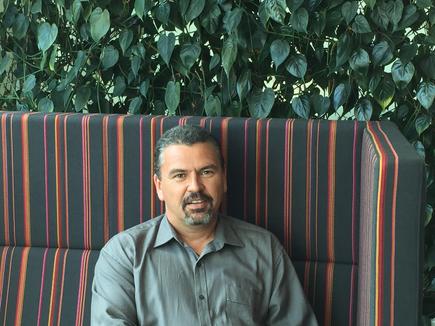Prime movers: ICT transformation at KiwiRail
- 23 February, 2017 09:23

Photo by Divina Paredes
I want my team to be having a conversation with the business about their applications, not infrastructure.
Ed Overy recalls a challenge KiwiRail CEO Peter Reidy threw him at the start of 2015.
“I want you to look at delivering IT services in a different way,” Reidy told Overy, who at that time had been CIO at the state-owned enterprise (SOE) for just over a year.
“I want you to look at, if you can, reduce cost and see if you can move it from a fixed cost to a variable cost model.”
Overy says IT was a microcosm of the whole business of KiwiRail.
“We were a very traditional IT outfit. We were wholly insourced, there was a capital model for infrastructure and equipment. We did not own our datacentre but we owned all of the gear inside.”
The focus, he says, following his conversation with Reidy was on rationalising the ICT spend to ensure best value for the organisation.
The ICT landscape was reviewed and it was determined how best to deliver the service.
“We outsourced the ‘run’ functions and migrated infrastructure to the cloud,” says Overy.
In a nutshell, the transformation encompassed four changes.
First, KiwiRail moved the infrastructure to as a service model, Spark-based private cloud, and moved to managed services in a highly resilient facility. “This enabled an improvement in our disaster recovery position,” says Overy.
The there was a rationalisation and outsourcing of the network and telecommunications.
Thirdly, service management (including the service desk) and end user services (laptops, phones and so on) were outsourced to Spark Digital.
Finally, the project management and PMO function was also outsourced to LPS (formerly Lexel).

Driving towards as-a-service
Overy says after the discussion with the CEO, he met with another CEO, Tim Miles.
Miles was then CEO at Spark Digital, which was also undergoing a similar business transformation programme.
“There were commonalities between our two businesses,” says Overy.
“Both were networked businesses with long legacies.”
Spark, he says, goes back to Telecom New Zealand and before that, the New Zealand Post.
KiwiRail, on the other hand, goes back to TranzRail and New Zealand Railways.
“Both were high asset businesses that were needing to transform.”

We are leaner and faster-moving
Overy says Miles discussed the business transformation model they were using at Spark.
“It was a process of identifying opportunities, qualifying those opportunities and then acting on them quickly.”
Overy says he sought permission from Reidy, their CEO, and engaged directly with Spark on how KiwiRail could implement a similar process.
This was in February, 2015, and from there, “we identified different opportunities we could do to transform,” says Overy.
“But quite quickly, it became apparent some form of outsourcing or changing the delivery model would provide a large opportunity.
The company worked with Spark through the middle of 2015. KiwiRail as a state owned enterprise was able to access All of Government Contracts and processes for the transition.
“What that means is that government agencies, instead of having to go have a full-blown procurement process, actually can pick one of the panellists (of which Spark was one) to engage with.”
“We identified a form of outsourcing would be a sensible thing to do developing and we were developing a business case in conjunction with Spark.”
While undertaking the due diligence process with Spark, Overy filled an information gap - how much their current services cost.
Overy says the technology team looked at KiwiRail’s total spend on IT from March 2014 to March 2015.
“We allocated every single dollar against an activity and we got to a point we knew exactly what each activity cost us. We gave it to Spark and said, ‘If you are going to do a proposal you need to bid against that, rather than through a hypothetical model.’"
The scope of services Spark proposed was infrastructure operations, IaaS provided by Revera, and then wrapped around that were IT managed services including service desk.
In July 2015, we went to the board with a business case recommending the outsourcing with Spark, says Overy.
“The board requested a third-party review of the business case to validate it and then they went to contract negotiation with Spark in November 2015.”
The contract stated that from 15 February 2016, Spark would provide the managed services and infrastructure operations.
“On that day Spark took over the responsibility for managing responsibility for KiwiRail’s IT platforms,” says Overy. As well, 22 people shifted from KiwiRail to Spark.
From a headcount of 162, the IT team went down to 50.
KiwiRail, however, retained the application and architecture teams. “Those are the areas that have key IP about KiwiRail,” explains Overy.
He says those made redundant were treated with dignity and respect. “We spent a lot of time on change management and communications through 2015 around this process,” he says.
He says today, KiwiRail no longer has any datacentre infrastructure. It will be a truly private cloud, effectively as a service consumption model.
“The IT services transformation is effectively complete,” he says.
By the end of last year, the team had completed the migration of 700-plus servers, two petabytes of storage and more than 200 business applications.

Criteria for success
For Overy, a real success criteria was the business did not notice the transition was happening.
All of the work being done now, he says, is getting ready for the application transformation.
The team did an inventory of applications, which ranged from SAP and Maximo to mid-tier, bespoke in-house applications. There were also spreadsheets with sophisticated macros that were used for rostering and looked more like an application, he says.
The inventory identified 206 applications. “We found we had a lot of applications that did asset management and a suite of applications looking after property and real estate, while others were on people management and operations.
“You could very quickly see the opportunity for deduplication or simplifying it,” he says.
As well, the organisation is moving to Office 365, its first true public cloud migration.
“The next job to do on the infrastructure side is what services can we move to public cloud, Azure or Amazon. We will work with Spark and Revera to identify that with a view to driving costs down.”
For this process, they talked to the New Zealand Racing Board, which had moved its wagering platform Jetbet to Spark’s datacentres.
“We reference check with a number of customers around this kind of work,” he says.
“What we have done with the application team is change their responsibility, broaden their scope so they are now service owners to the business for the IT services they consume.
“I want my team to be having a conversation with the business about their applications, not infrastructure,” he states.
“You’re responsible for the application support, but also for the roadmaps, the strategic direction for the cost and development and enhancement for everything in the domain of services you provide.”

The next job to do on the infrastructure side is what services can we move to public cloud
“What we are starting to bring in are contemporary techniques to the team, like DevOps and Agile methodologies."
“We have touched everything,” he says, referring to their review of the systems and applications, “so everybody has a good feel or knowledge of what we are managing.”
“It is like moving house, you know where everything is,” he says.
The contract negotiated with Spark was outcomes-based, he says. “What we want to see over time is reduced costs, introduction of innovation, improved service quality and management of risks.
“Getting out of the business of running IT infrastructure and being purely business focused, actually positions us for starting to have those conversations with the business.
"The transformation positions the company to take advantage of more contemporary technologies," he points out.
One of these is the Internet of Things. “We are an asset intensive business, we have 4000 kilometres of rail, we have nearly 200 locomotives and six-and-a-half thousand wagons. So the opportunity for IoT and big data is huge.”
He says another area they are keeping an eye on is automation, in particular self-driven vehicles and how these will impact transport and supply chain businesses.
He notes late last year, Uber completed the first commercial shipment using self-driving technology for a truck that delivered a cargo of beer. The truck drove itself 120 miles from Fort Collins to Colorado Springs while the driver sat in the sleeper berth.
“And you go, how does that impact my business today and how do we take advantage of those things?”
He discusses how he and and his team are taking on a more holistic long-term view of the organisation.
“We are looking at the value of rail to New Zealand, not just KiwiRail as a company. What are the economic and social values of rail to New Zealand?”
He explains the company employs over 3000 New Zealanders, and moves around 18 million tonnes of freight.
“We carry the equivalent of a million truck trips a year,” he states.
As well, KiwiRail is working with the New Zealand Transport Agency and Ministry of Transport on integrated land transport initiatives.

He is proud of what the team has achieved, as it moved from traditional to contemporary ICT operations.
“We are leaner and faster-moving,” he says. “We mitigated a lot of risks, and we are using contemporary practices and approaches we could not have done before.”

Send news tips and comments to divina_paredes@idg.co.nz
Follow Divina Paredes on Twitter: @divinap
Sign up for CIO newsletters for regular updates on CIO news, views and events.

